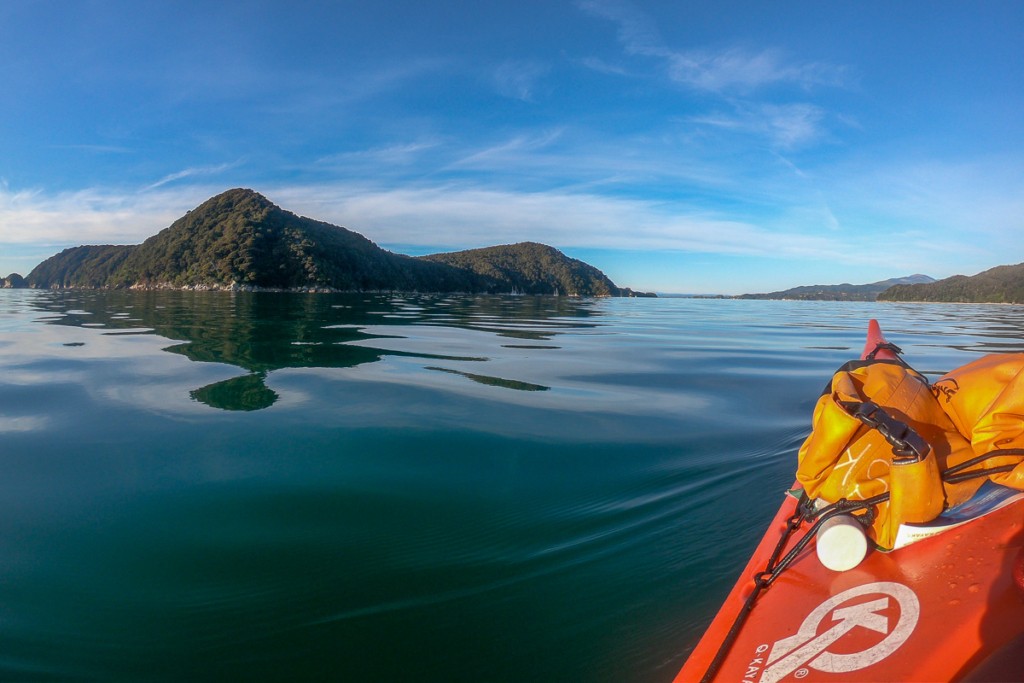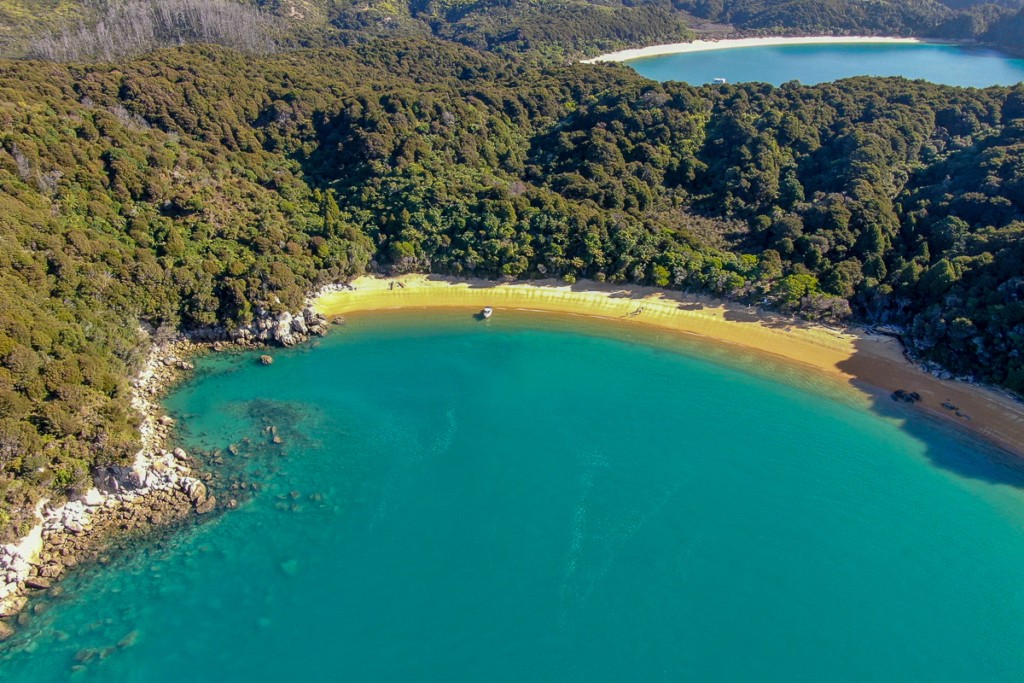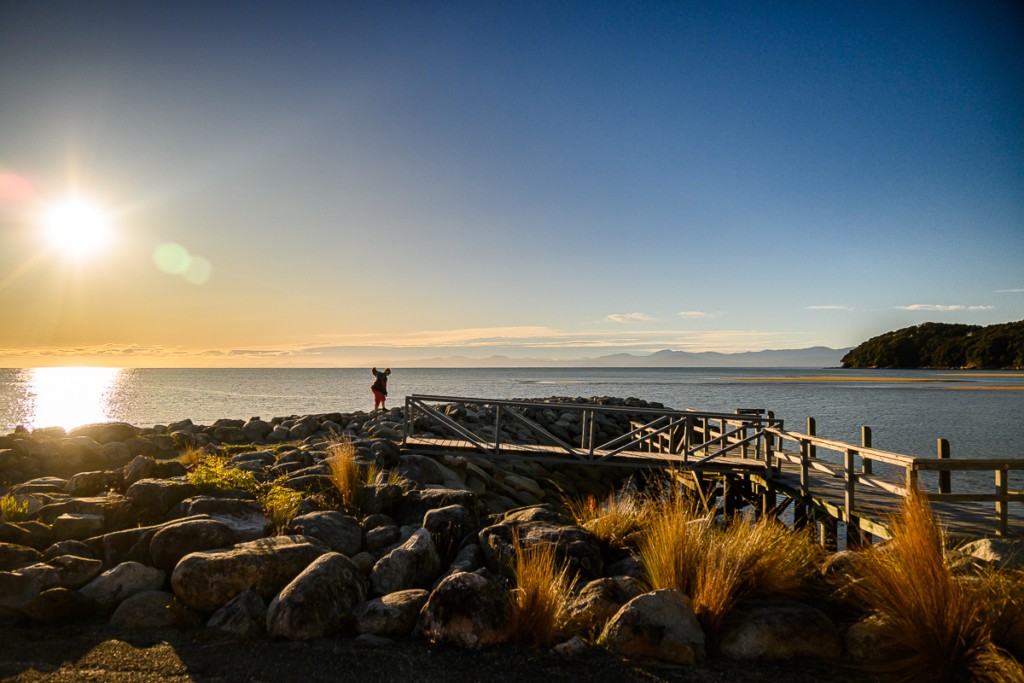A quintessent winter day in the Nelson Tasman region starts out with clear blue skies, temperatures hovering around zero and the grass covered in a layer of frost. By mid-morning however, the temperatures will be approaching the mid-teens, layers of clothing will need to be removed as the sun shines throughout another blue sky day.
While the summer months are marked with daily sea breezes, which almost always come up in the early afternoon, winter days are often characterised by clear, still days and calm sea conditions. Sure, it’ll get cold again when the sun goes down, but the middle of a winter day is often the perfect time to get out into the Abel Tasman. Because it largely consists of granite sand, the Abel Tasman Coast Track drains quickly during and after rain so even when it’s not one of the clear blue days as described above, it is still enjoyable in conditions somewhere south of optimal.
Although hearty alpine tramping types will camp out in tents in all conditions, I would recommend staying in one of the DOC huts in the Abel Tasman if you are doing an overnight trip in the park. If you’re doing a daytrip, then there are many options that will have you back in Mārahau even when the days are at their shortest in the heart of winter. From the 1st of May to the 30th of September each year Abel Tasman AquaTaxis operates on its winter schedule. The water taxis still run seven days a week but the first sailing from Mārahau heading north in the morning is 30 minutes earlier, at 9:30AM, than it is in summer. Subsequent sailings are then at noon and 1:30PM, but you do need to book in advance as services will only run if people have pre-booked.
The Falls River trip is perfect for people of all ages and almost every fitness level. You board the water taxi at 9:30AM and after checking out Toka Ngawha/Split Apple Rock and the NZ fur seal colony on the northern tip of Adele Island you’ll be dropped off at Torrent Bay. After walking up the little hill at the northern end of the beach you’ll get an excellent view of the largest collection of private holiday houses in the park, down the length of the Torrent Bay beach and across to Anchorage. The 7.8km walk takes you along a ridgeline from which you can look down on some lovely secluded bays like Frechman, with its beautiful tidal inlet behind the small beach. Crossing the Falls River swing bridge is a highlight as it provides postcard views down the river to the open ocean. Sandfly Bay and Medlands are both lovely beaches worth checking out enroute before you walk around an elevated track to Bark Bay to meet your water taxi back to Mārahau at 3:15PM.
The Pitt Head Walk trip is also perfect for anybody, particularly family groups with youngsters. You board the 9:30AM water taxi and after the customary visit to Toka Ngawha/Split Apple Rock and to check out some NZ fur seals, you’ll be dropped off at Anchorage. At the southern end of the Anchorage campsite a track takes you over to Te Pukatea, arguably the most quintessential of the quintessential Abel Tasman beaches in the Abel Tasman. With rocky headlines at either end of a crescent-shaped, golden-sand beach, Te Pukatea is the perfect place for a picnic and even has picnic tables for that purpose. The loop track starts at the other end of Te Pukatea and takes you to the end of the headland before offering spectacular views of Anchorage and Torrent Bay as you return to Anchorage to catch your 3:30PM water taxi back to Mārahau.
You’re probably thinking that winter is not an ideal time to be signing up for a water-based activity? However, winter conditions in the Abel Tasman are often ideal for a paddle in a kayak as the wind and ocean currents are usually calmer than they are at other times of the year. If you’ve got somebody prepared to spend the day with you in a kayak then you can rent a double kayak from Marahau Sea Kayaks to spend the day paddling in the southern part of the Abel Tasman. After being issued with all of the gear you will need, including clothing that will keep you dry and warm, and some detailed instructions on how to paddle and steer your kayak you’ll be on your way. In the winter the options for briefings are at either 9:00AM or 11:00AM, but you do need to book at least a day in advance.
After paddling across the bay from Mārahau into the Astrolabe Roadstead you’ll have the day to explore the beaches along the coast and Adele and Fisherman Islands. At the northern end of Adele you will find a NZ fur seal colony, but you need to make sure you do not get any closer than 20 metres to the seals or the rocks where they could be present to stay on the lawful side of the NZ Marine Mammal Protection Laws. You can spend as long as you like paddling around exploring the beaches and inlets as long as you have your kayak and gear back in Mārahau by 3:30PM.

If you are planning to walk the entire Coast Track the DOC huts are spaced along the route perfectly to enable you to spend each night in comfort and warmth. From Mārahau you can either walk into the park and then return via water taxi from Tōtaranui, or you can water taxi straight up to Tōtaranui and then walk back to Mārahau.
The other decision you need to make is whether you are going to include the leg of the track from Whariwharangi to Tōtaranui or simply skip that part and walk directly south. Water taxis are only permitted to drop you as far north as Tōtaranui so you will need to do this bit on foot. It can be done as a loop, rather than having to walk north up the coast and then back south retracing your own footsteps. I would recommend getting dropped at Tōtaranui and then doing the Gibb’s Hill track up to Whariwharangi on the first day before staying in the hut. That walk is only 4-5 hours so I would catch either the 9:30AM or noon water taxi from Mārahau so you’re not doing the final bit in the dark. However, the track is easy to follow if you catch the 1:30PM water taxi as long as you’ve remembered your head torch.
On the second day you walk the coastal route from Whariwharangi, making sure you do the side track off to Separation Point before continuing on to Tōtaranui, which will be your start point on the first day if you are walking directly south. The walk from Tōtaranui to Awaroa, the location of the second hut, is 7.1km so a walk of 2.5 to 3 hours. You will only be able to get across the Awaroa Inlet for two hours either side of low tide so you need to check the tide times on the day you are planning to cross.

On the third day you have an easy 13.2km, 4.5 hour walk to Bark Bay via Onetahuti and Tonga Quarry. This is another wonderful stretch of the Coast Track and you have the whole day to stop off on the way to enjoy the beaches. After spending the night in the Bark Bay Hut the next day will be either be an 11.8km, 4 to 5 hour walk if you need to take the high tide route around the Torrent Bay estuary or only 8.7km if the tide is low enough for you to scoot straight across from Torrent Bay to the hut at Anchorage. If the low tide route is passable I would still walk around the estuary as it is one of the most underrated sections of the whole coast track in my opinion.
Once in Anchorage you would be an absolute mug if you didn’t drop your pack and then walk the Pitt Head Loop at the southern end of the Anchorage, via the rather lovely Te Puketea. The Pitt Head Loop is only 1.5km so an easy 1-1.5hr walk. Once you’ve spent the night in Anchorage Hut the walk back out to Mārahau is only 12.4km so will only take 3-4 hours, but there are so many awesome beaches dotted along the route I would make a day of it by walking from the track the short distances down to at least a few of those beaches. Once you hit Mārahau you’ll be able to look at the Islands in the Astrolabe Roadstead and reflect on how you probably should come back and do it all by kayak next time!
Words by Brendan Alborn
Owner Operator
Brendan has a long association with the Abel Tasman, visiting it for the first time when his parents moved to Marahau in 1997. After spending much of his life overseas, Brendan and his family moved to the area at the end of 2010. When Brendan is not spending his time in the outdoors he seems to spend much of his time creating even flimsier justifications for spending more time in the outdoors.

